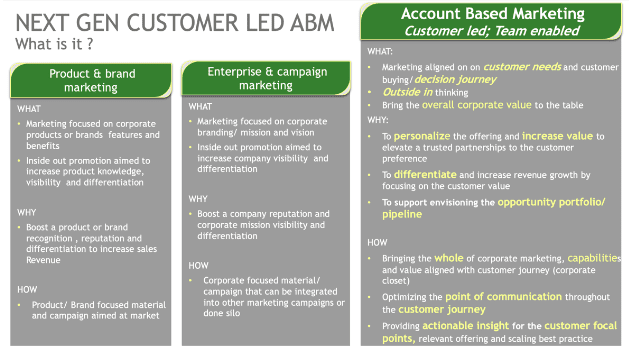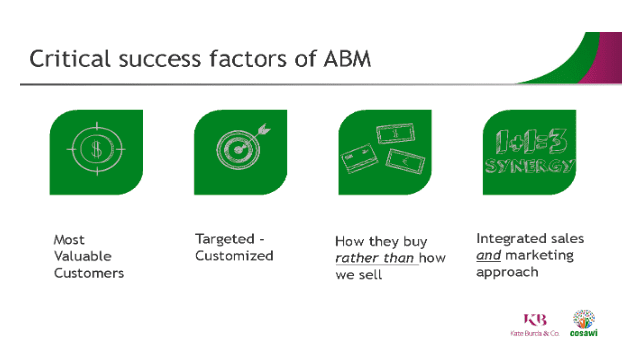ACCOUNT-BASED MARKETING: TIME TO FUTURE PROOF YOUR MARKETING EFFORTS TO BECOME CUSTOMER-LED AND TEAM ENABLED
By Dominique Côté
Owner & Founder
Cosawi
By Kate Burda
Owner & Founder
Kate Burda & Company
In both our careers, we have seen sales and marketing joined at the hip; although sometimes siloed, they have traditionally worked together in parallel. Today, as advisors in the strategic account management space, we are surprised and disheartened to see that marketing is often not only missing at the strategic account team table but also working from an inside-out products focus, rather than an outside-in customer focus.
In our work with best-of-class ABM organizations and next-generation thinking, as well as our work having led this corporate journey as practitioners leading marketing and customer-centricity strategy, we have identified two key insights on the subject
Insight #1: From marketing-led, sales-enabled to customer-led, team-enabled
Best-of-class marketing focuses on the customer. Most would agree. Yet when you look at account-based marketing campaigns, we often see a product-focused orientation that endorses a siloed, less customer-centric approach. This approach is typified by the marketing-led, sales-enabled construct, which was born out of the time-worn approach of “pull, push” strategies whereby companies simultaneously push their brand in front of an audience to build awareness and pull potentially interested customers into their pipeline.
In our work, we have reviewed the methodology whereby organizations have a marketing-led, sales-enabled approach, and what we have found is that little to no consideration is given to the customer, the customer buying journey or their satisfiers and dissatisfiers. As part of our customer buying journey mapping work, we have delved deeper not only into where the customer is headed, but what their state or mindset is at each given step as they progress on their decision making. For example, at one point in the journey, the customer may be ambivalent or frustrated. At another point, decision remorse may be setting in. This creates a customer who is connected to a transactional relationship rather than a true partnership. Could one, or all, of your strategic customers feel this way about your company and you? If you answer yes, then clearly a different approach is required. Additionally, the customer journey approach gives us a framework that brings a deep understanding of the customer’s point of view and their buying decision-making journey, rather than internal account management or campaign marketing.
Customer-led thinking, on the other hand, puts the customer as your central focus and then looks at which discipline of sales, marketing, or another e.g., executive engagement, is best suited to engage the customer where they are in their customer journey. These communication opportunities are key to personalized, targeted connections. Taking this approach optimizes the engagement between the strategic account manager and marketing in this co-orchestration of the account plan.
Let’s take a deeper look at the ever-popular campaign marketing (a.k.a., “awareness marketing”) packaged as account-based marketing. Even though marketing teams are starting to share insights rather than pushing products, they are still not connecting to what the customer is thinking and feeling at any given point on their buying journey. We also have noted the presence of separate workflows, which are often in conflict between the marketing campaign plan and the sales account plan. Even though teams have moved away from simply pushing products, they still are not aligned with what the customer values most.
For the customer, this lack of alignment between the supplier’s marketing and sales efforts, engagement and planning is noisy, disruptive and, above all, frustrating for customers. Next-generation customer-centric ABM relies on the customer buying journey to set the pace as to the points of communication, messaging and who within the commercial team is best to deliver each message. Doing this well will accelerate any SAM journey, differentiate your company from the competition and future-proof your business.
Insight #2: Aligning mindset and ways of working of SAM and ABM
There are many marketing associations and thinking out there who define ABM as going from brand marketing to campaign or awareness marketing and then building a marketing plan from that perspective.
Although brand and awareness campaigns have their place, they do not represent true account-based marketing because they focus on either marketing or sales perspective– creating gaps in execution due to a lack of alignment, thinking and differentiated ways of working. To create the agility, speed and competitive edge required in the world we live in, teams cannot afford siloed work within commercial teams. The Strategic Account Manager, the Account-Based Marketer or any of the Account team need to have more consistent and relevant conversations with the customers.
A customer-led ABM construct facilitates that integrated pathway to becoming customer-centric and ultimately more effective. Why? Because teams start from the customer’s point of view rather than a product or even campaign orientation. Doing so expedites an integrated approach by bringing the Account-Based Marketing and the SAM together. This next-generation ABM architecture creates a future-proofed roadmap and agility to work in parallel with customers while breaking down debilitating silos. When well-executed, account-based marketing provides a pathway to anticipating where the customer is trying to go and helping the customer get to where they want to go sooner, less expensively and with greater value realization. This in turn rewards the progressive, ABM embracing company by being seen as a forward-thinking and customer-centric supplier who focuses on deploying the total value of their company’s capabilities where and when the customer needs them.

Is ABM strategic or tactical?
We get many questions about omnichannel campaigns and deployment, and – although important – the upstream work needs to be done first. In today’s data- and technology-rich environment, marketing needs to be strategic, outside-in and a source of value in co-orchestrating the account strategy and value offering. This is a stark contrast to the traditional inside-out approaches of either sales-enabled, marketing-driven or marketing-enabled, sales-driven.
In today’s digital economy, we need to start with how the customer wants to connect with us at each stage of their decision-making journey. Research from Forrester (Myth Busting 101: Insights into the B2B Buyer Journey, Forrester Blog, May 2015) shows that 75 percent of customers conduct more than half of their research through social media and digital channels before connecting with a supplier! This means that the bulk of their thinking is done before the supplier organization has the chance to influence the buyer’s thinking. What this says to us is that suppliers must revise how and when they engage with their customers so they can be more relevant.
If we look at some highly relevant pre-COVID marketing insights from one digital expert in the marketing world, Neil Patel, we discover the following:
- Fewer than three percent of customers click through emails that come from outside their organizations
- In contrast, personalized email can increase open rates by a factor of six!
- Beware! Personalization does not just mean putting the recipient’s name in the first line; it means making sure your email is relevant to their current needs and interests.
- Based on Neil’s research aligning to how the customer buys results in a 73% greater deal size with 91% of the ABM accounts generating a higher return on investment.
- How? The answer lies not in how you sell but in aligning to how your customer buys.

So what is the difference between traditional ABM and customer-led ABM?
Traditional marketing is based on pushing products – on translating the value of a company’s products into features and benefits. It is based on the mass distribution of marketing information – the one-size-fits-all, generalist approach. It creates brand awareness by focusing on an inside-out approach.
We see and hear a lot of ABM definitions, and one of them is about going from marketing one-to-many to marketing one-to-one to focus resources to increase their return on investment. In the one-to-one scenario, the supplier is trying to distill the value of targeting customers. In practice, it has become a general definition of strategic account management and the SAM principles to focus on the most important customers. But this is only the starting point. One can have a one-to-one targeted marketing, yet still miss the mark of being engaged with customers by supplying insights they value in bulk. Insights are only valuable if they are given at the right time, through the right channel and with the right messaging. Done otherwise, it is not targeted marketing nor targeting customers effectively.
Next-generation, customer-led ABM goes beyond the one-to-one relationship of selected strategic accounts by bringing insights at the right time given what customers are thinking about at any given moment – starting from the point of inspiration and extending throughout the lifetime value of the relationship. Customer-led ABM is about owning the customer journey as a commercial team and helping to gain a deeper understanding of the 360-degree view of the customer to bring the right message at the right time.
So, what does marketing bring to the table? Since they are often a lot more ingrained into the internal organization, marketing can help the SAM and account team in two main ways: (1) to navigate the internal organization and (2) to bring the total view of all organizational capabilities that can be part of the value offering that serves to differentiate the supplier in the mind of the customer. This assumes marketing understands the pressures, problems and challenges the customer’s entire industry is grappling with and helps by providing these insights to help the SAMs differentiate themselves in front of the customer, co-orchestrating with the SAM and helping the account team members be seen as trusted advisors.
But ABM is not only about bringing insight; after all, you can have insights that are totally misaligned with your customer’s needs and area(s) of focus. Rather, ABM is about sharing a customer-relevant insight that aligns with customer needs, objectives, focal points and where they are at in their decision-making process.
How do the best teams leverage ABM?
What we see the best organizations doing in the account-based marketing space is integrating the practice into the account team and making it part of the business transformation and cultural shift. Specifically, this is how we see marketing teams contribute to the strategic account management journey by providing trends and relevant insights aligned with personas to optimize the SAM impact and engagement. Account-Based Marketing:
Creates continuous business intelligence and trends reports in support of the SAM’s engagement with the customer’s interest, focal point and needs, and proactively helps them envision the future by sharing things they do not yet know or see
Prioritizes the most important strategic customers to get profitable growth and brings value beyond products/services and traditional marketing
Creates and relies on each strategic customer’s journey mapping, looking at different personas and putting themselves in the customer’s shoes to embed a customer-centric perspective.
Develops and aligns the 360-degree view of possible personas and a detailed image of the buyers’ personas as well as market and persona insights
Optimizes the SAM customer point of communication by providing touchpoints and insights throughout the customer buying journey, personalized to the customer focal points and preferences
Activates an omnichannel strategy and deploy tactics aligned with the customer journey in a way that is targeted and customized to them
This is all well and good, but let’s look at some real-life examples.
A smaller commercial real estate developer (CREDCo) looking to increase market share identifies a segment of investors looking to do deals that are a good fit to grow their business. Rather than put together a marketing campaign based on general insights, they map out the buying journey for this specific segment of investors. It contains eight clearly defined stages, starting at the point of inspiration. In this case, the point of inspiration is an impending interest rate increase and corresponding concern about a shift in capitalization rates.
After mapping each stage from the point of inspiration to the point of purchase, CREDCo then makes insights-backed hypotheses about what their customers’ specific concerns will be at each of those eight decision-making points. With this done, the team devises messaging designed to shed light on the situation, help the customer form decisions, and spur investors to pause and consider something new. This means starting by sharing information on subjects like what types of development projects can become cash-flow positive quickly (and are therefore more recession-proof) and how to preserve liquidity. Lastly, they choose the channel to communicate these messages most likely to get the investor to advance the conversation.
No matter what you know about cap rates or interest rates in commercial development, the takeaway is that the real estate developer brought insights tailored to the investor’s position on the decision-making journey. And they made sure to choose the best channel to get that message across to their target customer. Remember: Your sales team is one channel of communication. The developer looked at repeating this thinking for each stop along the journey through the point of agreement or sale and beyond.
In the healthcare sector, account-based marketing will map not only the customer journey but also the patient journey. It starts by creating a patient journey from the point of early symptoms to the point of treatment, cure, or stabilization. Using this patient journey informs the customer journey and helps form a 360-degree view of the decision-makers through the lens of the end receiver: the patient. The channels of communication and point of communication can then be optimized to create synergies in the omnichannel go-to-market strategies.
For example, an epileptic patient’s journey starts with a first seizure or event, then goes into the journey of denial, fear & searching for information, seeing a physician and getting the diagnosis. The next step is trial and error for the patient’s treatment until he is stabilized or controlled. Through this mapping of the patient journey, you can highlight some additional pain points like being able to prevent a seizure, myths around and how to talk about epilepsy, fear of going back to a normal life if something happens in a public setting, etc. Alongside the patient journey, we can look at the customer journey from the first encounter to the controlled status of the patient. Having both journeys inform the patient on the reality of what the patient goes through, thinks, and lives. As a company, using the patient journey to have the point of communication at the right time to help inform them is critical and accelerates the journey and the positive outcome by targeting the emotions throughout their journey and helping with focused information through different channels. For the healthcare group, the patient journey and targeted information enable to really understanding broadly the patient and evolution of feelings while also using additional sales channels to target every step and optimize the SAM interaction.
How to ignite the journey and integrate marketing into the account team
Starting the fire internally and going beyond collaboration to integration can be challenging.
In our work, we know that navigating our internal organizations is often more challenging than navigating the customer organization. So how can SAM and ABM help to create this harmonious dance to become co-orchestrators of the account plan?
When both marketing and SAM work together, they can bring more value to the customer. As the owner of the account relationship, the SAM brings direct customer insights, knowledge and business/financial/technical context (i.e., serving as the voice of the customer). Having the account team working hand in hand together is critical to creating a value-based portfolio of opportunities that will drive success for both our customers and ourselves. By bringing together different perspectives in a design thinking environment where each participant brings her own domain experience, new ideas are rapidly generated, evaluated and either implemented or discarded quickly through an iterative process.
By working in this integrated manner and being a customer and account advocate, marketing can articulate and disseminate the business case and help execute the opportunity commitment by optimizing the customer’s and account engagement through targeted, personalized, and synergistic communication points using an omnichannel strategy. Doing so will accelerate both customer and supplier success and elevate the trusted partnership by leveraging the strengths of the account team.
You now have clarity on customer mapping, the points of communication with differentiated messaging, and the different go-to-market channels to use to show up in a personalized and relevant manner to the customer.
The next step is to look at the account plan actions to see how the integration between ABM and SAM can execute the plan in an integrated manner. Specifically, it is about scoping which actions will optimize the role and impact of the SAM in the engagement and then dividing relevant activities – not in a random manner but aligned with the opportunity and objective you are trying to achieve. Integration is about co-orchestrating the account plan, taking into consideration the customer journey to expand our customer-centricity and understanding to build a continuous opportunity pipeline thanks to having a broader, deeper and wider view of the customer. The team successfully applying this team-enabled approach is fully prepared to achieve the customer’s and your companies’ objectives.
Prioritizing these opportunities together helps create the account plan strategy and opportunities portfolio in a team-enabled manner.
In summary, here are the key takeaways on next-generation, customer-led ABM:
- There is no such thing as the worn-out approach of marketing-first, sales-second approach. Strategic Account Management is a team sport.
- The account-based marketing plan and account plan should be the same document that starts with the customer buying journey and defines how each of our disciplines plays a vital role.
- Next-generation, customer-led ABM breaks down silos and integrates the sales and marketing approach aligned with the customer’s buying journey versus a loosely defined, collaboration.
- Campaign marketing is not necessarily ABM. You can have one-to-one campaign programming and still be irrelevant to the customer’s needs.
- Insights are good but don’t by themselves make account-based marketing. Insights at the right time, with the right message that speaks to where the customer is on the buying journey, is the best-of-breed mentality.
- The account plan holds the total commercial team accountable – not just marketing, not just the SAM, but the entire team.
Research from Gartner cited 5 ways the future of B2B Buying will rewrite the rules of effectiveness. Gartner, 5 Ways the future of B2B building will rewrite the rules of effective Selling, Brent Adamson, Nick Toman, August 2020. Their key finding shows that B2B buyers report spending only 17% of their time engaging with sales teams. Efficient and effective Strategic Account Management has never been more of a team sport than it is now with Account-Based Marketing playing a critical role to optimize the customer’s experience in a concise and integrated manner aligned with and driven by the buying and decision-making journey of the customer is on.
In the work we do, we see some of the best companies having one marketer dedicated for each top strategic account and providing this Account-Based Marketing co-orchestration of the Account with the SAM. This being said, it needs to reflect the reality of the company’s organization and the maturity of the strategic account management journey. Often, it can be ignited by having a marketer that understands the principles of strategic account management and Account-Based Marketing playing the role of the connector with the rest of the marketing department and being part of a few account teams. These marketers get it and are passionate about the changes needed within marketing to become more outside-in thinkers and integrated into the account teams. In our experience, the best way to achieve this is to do it slowly and aligned with the right cultural change and roadmap needed to accelerate after.
When done well, next-generation customer-led ABM will yield amazing results. But beware: The game is changing at the speed of Google, and what worked in the past will not necessarily work tomorrow. You need to have an ever-evolving go-to-market strategy and metrics to guide the team to success when deploying an ABM-SAM coordinated effort. And always remember: Strategy comes first, with seamless team co – orchestration and integration providing the biggest differentiating factors.
Download the Article HERE
Watch the LinkedIn Live Event Here
Recent Posts
IS YOUR SAM JOURNEY STALLED?
By AKAM Board Members Olivier Rivière (Powering), Armelle Dupont (Vetropak), Dominique Coté (Cosawi)Exploring methodology, governance, and organisation Setting the framework for thinking about K/GAM When considering the design of a Key or Global Account Management...
THE ESSENCE OF KAM/GAM
By AKAM Board Members Olivier Rivière (Powering), Armelle Dupont (Vetropak), Dominique Coté (Cosawi)Exploring methodology, governance, and organisation Setting the framework for thinking about K/GAM When considering the design of a Key or Global Account Management...
Why isn’t Marketing in the KAM/ SAM journey ?
By Dominique CôtéCEO & FounderCosawi Why isn’t Marketing in the KAM/ SAM journey ? Customer-Led and Team-Enabled Marketing In the evolving landscape of Key Account Management (KAM), Account-Based Marketing (ABM) has emerged as a cornerstone for driving...



